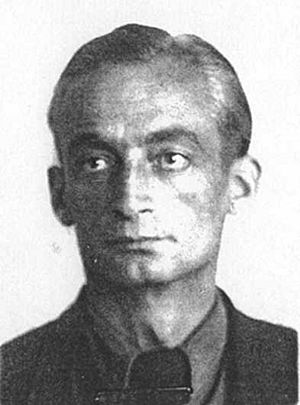Siegfried Knemeyer facts for kids
Quick facts for kids
Siegfried Knemeyer
|
|
|---|---|
 |
|
| Nickname(s) | Knall Max, Knall Kne, Star Gazer |
| Born | 5 April 1909 Ellerbusch, Germany |
| Died | 11 April 1979 (aged 70) Ohio |
| Allegiance | |
| Service/ |
|
| Years of service | 1939–45, 1947–79 |
| Rank | Oberst |
| Awards | Iron Cross First and Second Class German Cross in Gold Knight's Cross of the Iron Cross Department of Defense Distinguished Civilian Service Award |
| Other work | Aircraft consultant |
Siegfried Knemeyer (born April 5, 1909, died April 11, 1979) was a brilliant German engineer and pilot. He was a key leader in developing aircraft for Germany during World War II. After the war, he continued his important work in the United States.
Contents
Early Life and Inventions
Siegfried Knemeyer studied at the Technical University of Berlin. He graduated in 1933 with degrees in physics and aircraft engineering. He was also part of a student flying group. In 1935, Knemeyer became a flight instructor for the German Air Ministry, which was a civilian group that helped the military.
By 1936, Knemeyer had invented a special hand-held device called the Dreieckrechner. This was a type of flight calculator. It helped pilots figure out things like how far they had flown and how much fuel they needed. This device became very common for both military and civilian pilots in Germany. When World War II started on September 4, 1939, Knemeyer joined the German air force, known as the Luftwaffe.
World War II Contributions
Reconnaissance Missions
After flying for Field Marshal Walter von Brauchitsch during the short invasion of Poland, Knemeyer joined the Rowehl Reconnaissance Group. As part of this group, he flew many spy missions across all the areas where Germany was fighting.
In late 1939, Knemeyer flew a mission to Narvik, Norway. He wanted to see if the British navy was using the Narvik seaport. During this flight, he took pictures of the British Home Fleet (their main navy ships) at Scapa Flow. He even managed to escape two British Spitfire planes while getting these important photos. Based on the information he gathered, a German submarine, U-47, sank the British battleship HMS Royal Oak. For this brave mission, Knemeyer received his first Iron Cross award.
Leading Aircraft Development
In April 1943, Knemeyer became a technical officer for General Dietrich Peltz. Peltz was in charge of the air war against England. In this role, Knemeyer started a program to capture enemy aircraft. His team would then fix them up and study them. This helped Germany learn new things and gain an advantage in the air.
Later in 1943, German leaders worried that new Allied aircraft technology would make them lose the war. Hermann Göring, a top German leader, held a meeting to discuss this. General Peltz brought Knemeyer to this meeting. Göring was very impressed with Knemeyer's new ideas. After the meeting, Göring made Knemeyer his personal technical advisor. A few months later, Knemeyer was promoted to Oberst (a high rank) and became the Director of Research and Development for the Luftwaffe. Göring even called him the "Star Gazer."
In November 1943, Knemeyer was put in charge of Technical Development for the Reich Ministry of Aviation (RLM).
Advanced Aircraft Projects
By February 1944, Knemeyer had never flown a German heavy bomber. He finally got to fly a prototype of the Heinkel He 177B bomber. He thought the plane handled "excellently." Because of his positive review, he suggested that the Heinkel company should focus on building the He 177B.
After becoming a top technical leader, Knemeyer worked closely with General Werner Baumbach. Knemeyer was part of a special committee in November 1943. This committee pushed for Germany to build many Me-262 jet fighters. Many experts believe that Knemeyer and General Adolf Galland were the main people who made sure the Me 262A-1a jet fighter went into mass production.
In 1944, German leaders asked for new ideas to try and win the war. Knemeyer, who knew a lot about new technologies, suggested developing a long-range bomber. This bomber would carry a special weapon to a distant city. This idea led to a competition to develop the most advanced aircraft. Three main projects were involved:
- Wernher von Braun's Aggregat A-9 rocket missile.
- Eugen Sänger's Silbervogel, a special aircraft designed to fly very far.
- The Horten brothers' Horten Ho 229, a turbojet-powered "flying wing" fighter.
This competition helped speed up the development of cutting-edge aviation technology. However, only one prototype of the Ho 229 flew before the war ended.
Post-War Work in the United States
Operation Paperclip
After the war, Knemeyer was arrested in the British Zone of Germany. He was held in prison camps. Knemeyer later became part of Operation Paperclip. This was a secret United States program. It brought German scientists and engineers to America after World War II. The goal was to use their knowledge to help the United States.
In June 1948, Knemeyer was given a permanent job contract with the United States Air Force. His family was then able to join him in America. He started working for the United States War Department on July 1, 1947.
In 1966, Knemeyer received the Department of Defense Distinguished Civilian Service Award. This is the highest award given to a civilian by the U.S. military. It recognized his important contributions to aviation technology in the United States.
Awards and Recognition
In Germany
- Iron Cross (1939)
- 2nd Class
- 1st Class
- German Cross in Gold on July 27, 1942, as a Hauptmann (Captain) in the Air Force.
- Knight's Cross of the Iron Cross on August 29, 1943, as a Major (Major) in the Air Ministry staff.
In the United States
- Department of Defense Distinguished Civilian Service Award

